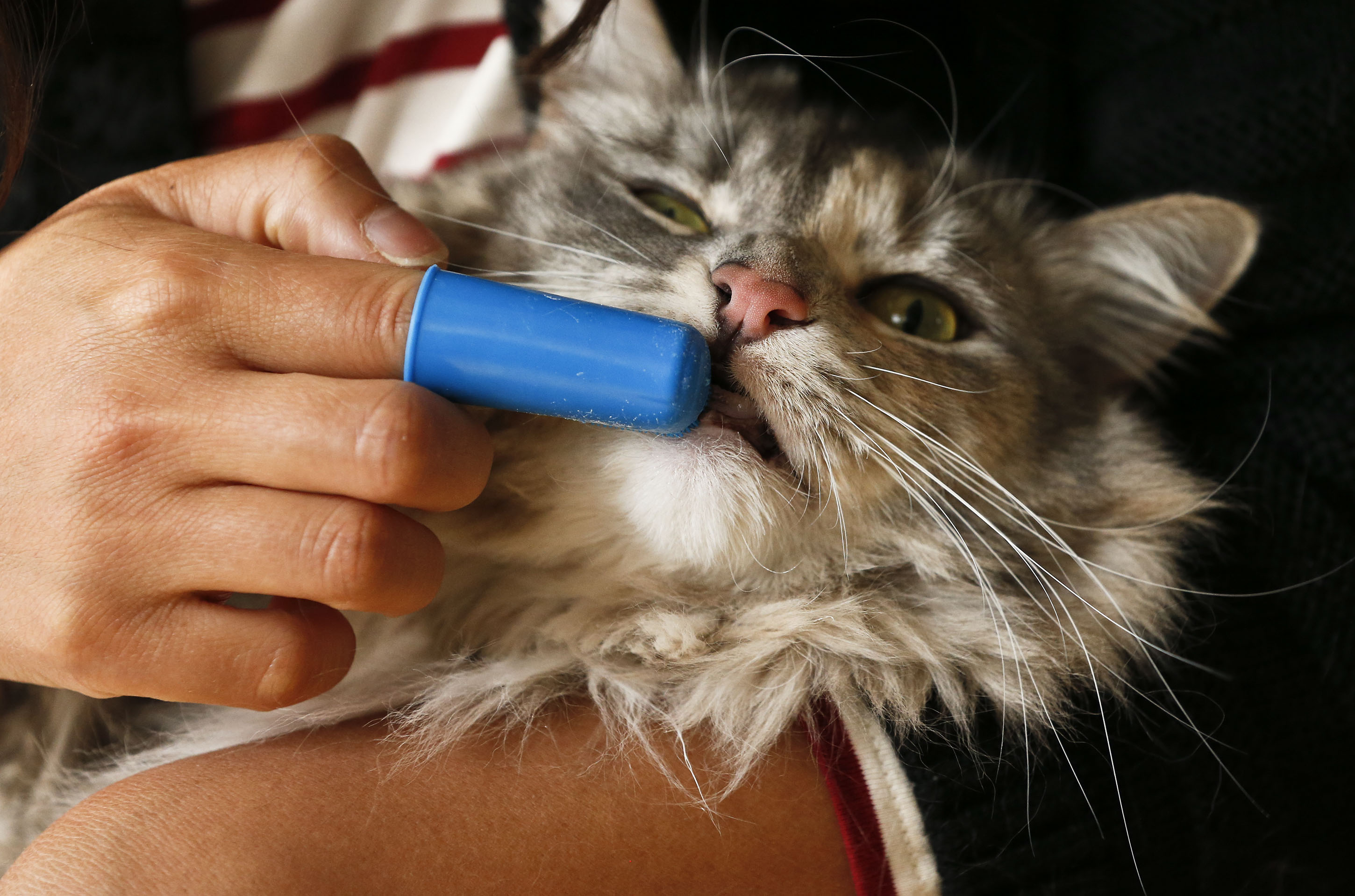Dogs and cats can't brush, spit, gargle or floss on their own, so owners who want to avoid bad pet breath will need to lend a hand.
"Dental problems with all animals crop up a lot," says Marsha Bustamente, hospital manager at Red Bank Animal Hospital. "Pets' teeth have all the problems humans have, only they're compounded in animals."
For instance, if a pet has gingivitis, or inflammation of the gums, "it can cause an infection in the gums, and that can spread through the body and infect the heart and internal organs," says Bustamente, who has been at Red Bank for 22 years.
So yes, pets need to have their teeth regularly brushed, but ... have you ever tried to brush the teeth of a squirming dog or cat?
"Brushing is the gold standard for good oral hygiene at home. It is very effective, but some dogs and more cats don't appreciate having something in their mouth," says Dr. Colin Harvey, a professor of surgery and dentistry in the Department of Clinical Studies for the University of Pennsylvania's School of Veterinary Medicine.
The bulk of bad breath odor -- the trademark rotten egg smell -- comes from hydrogen sulfide, which is waste from anaerobic bacteria that thrive without oxygen in places like gaps between teeth and gums. Plaque buildup also invites the bacteria and as the accumulation grows, so does the smell.
"That awful stuff in their mouth is nasty bacteria," explains Karen Walsh, licensed veterinary medical technician and executive director of McKamey Animal Care and Adoption Center. "Dogs not only end up with dental issues, but it's painful for them. If their gums are red, their teeth are loose or their breath is horrible, it's hurting the dog."
Walsh says McKamey frequently receives animals with dental problems. The shelter has a partnership with Chattanooga State Community College's veterinary technology program to handle teeth cleanings as part of students' training. The students provide free cleanings while receiving hands-on training, she says.
Many people don't understand how painful dental problems are for pets and how they can contribute to larger health problems, Walsh says.
"We call it 'flip the lip,'" she says. "Everybody should take their pets and flip their lips back to check teeth in front and back. If they don't look like you would want your teeth to look, then the dog probably needs a dental cleaning.
"They're swallowing all that, and it can affect their heart, kidneys and cause internal organ problems," she says.
Stacy Silva, community outreach coordinator for Santa Barbara County Animal Services in Florida, notes that wear on teeth could give the wrong impression of an animal's age.
"(The animals) may look a lot older than their teeth, and it may just be a matter of cleaning the tartar off that gets them back looking their age and that helps them to be adopted," says Silva.
Harvey, who has been director of the Veterinary Oral Health Council since it was founded in 1970, says chew toys or ropes and hard treats or cookies are good substitutes for a teeth-brushing. Pet owners can try a combination or use other products such as water additives, plaque and tartar cleaners and dental diets, Harvey says.
Puppies and kittens are born toothless. They get their baby teeth before they're a month old, lose them three to five months later and get their permanent teeth by age 1. Dogs have 42 teeth and cats have 30.
Toy dogs tend to have more dental problems because breeding for their smaller size hasn't caught up with evolution, Harvey says.
"Primitive dogs had a standard size and shape because they were evolved from wolves" but for toy breeds, their jaw size was reduced and tooth size was not, "so their teeth are too large for their mouths."
Christie Keith, a communications consultant to animal welfare and veterinarian groups in Michigan, says she spends about two minutes each night brushing the teeth of her three dogs after dinner. She believes most dog owners needlessly fear brushing their dogs' teeth.
Keith says she took it slow when she began brushing the teeth of her 8-year-old greyhound Val. She started with one tooth at a time and used a foamless flavored gel that dogs can swallow.
"She started to nibble (on the toothbrush) and I rubbed it on her front teeth. I didn't make a big deal out of it. I didn't worry about brushing the first half dozen times. It was just a little bonding thing. Eventually, I brushed one tooth. Now she stands there and lets me brush all her teeth," she says.
"But cats are another story," she adds.
Harvey says that's because cats' mouths are smaller, their teeth sharper and they could care less about bonding with a human during designated tooth time.
Oral care products for animals are generally not regulated by any federal agency, although the Food and Drug Administration monitors all products that claim to prevent or slow disease. The agency does not test products that claim cleaner teeth, fresher breath or the reduction of plaque and tartar, Harvey says.
The Veterinary Oral Health Council is not a regulatory agency but it uses American Dental Association guidelines to test pet plaque and tartar products. Test requests are voluntary but companies pay nonrefundable submission and annual maintenance fees. Products are given a VOHC seal if they pass.
The council has approved a human, ADA-compliant, flathead toothbrush with soft bristles and rounded tips for pet use. A child's brush can be used for small pets and an adult size for big dogs, but don't use human toothpaste on pets, Harvey warns, because they contain detergents that foam, and pets will swallow it instead of spitting it out.
Staff writers Susan Pierce and Clint Cooper contributed to this story.

